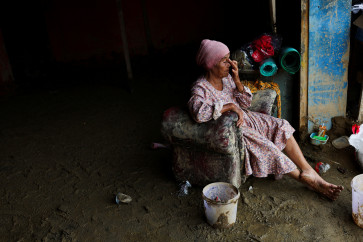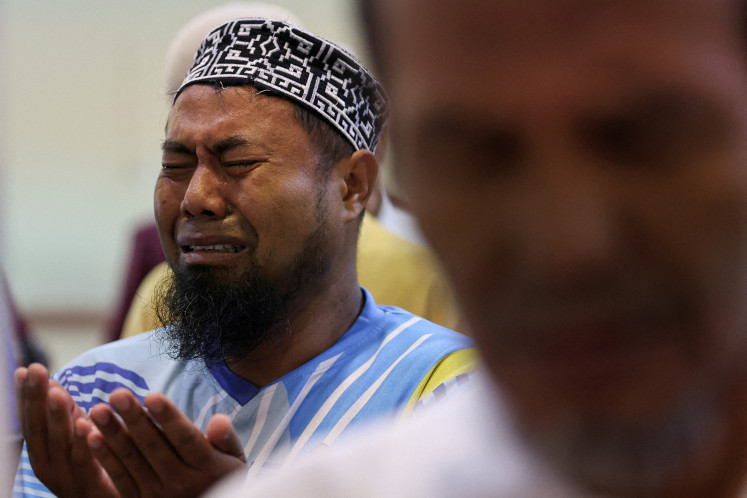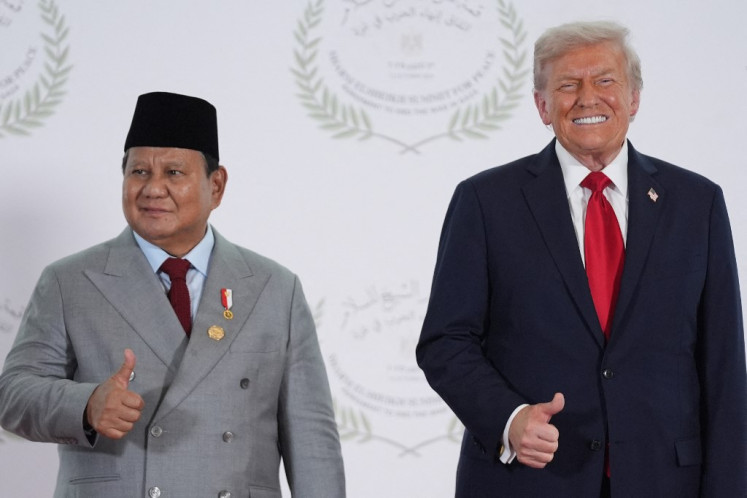Popular Reads
Top Results
Can't find what you're looking for?
View all search resultsPopular Reads
Top Results
Can't find what you're looking for?
View all search resultsSuccess at last for Bali's tallest monument
Welders work on the head section of the Wisnu while a model of the GWK lies in the foreground
Change text size
Gift Premium Articles
to Anyone
Welders work on the head section of the Wisnu while a model of the GWK lies in the foreground.
Darmaji was the most underdressed man in that solemn but triumphant ceremony on that Wednesday morning. Hanging clouds and light showers of rain had drenched Bandung in the previous days. That morning, however, the sky was blue and the warm sun blanketed Nyoman Nuarta's spacious sculpture studio in Sarijadi area.
In silence, Darmaji squatted in an empty corner not too far away from a huge, orange colored truck, his most loyal companion for years. His worn-out t-shirt, faded shorts and cheap flip-flop were in contrast with the sharp attires donned by the participants of the Balinese Hinduism's consecration and purification ritual taking place some twenty meters to the south.
A native of Mojokerto, East Java, Darmaji has been a truck driver plying his trade through inter-province routes for 20 years. He watched stoically as a Hindu temple priest sprinkled holy water on the truck and when Nyoman Nuarta and his wife Cynthia smashed a water-filled earthenware jug against one of its front tires. His face yielded no sign that his next load, a 3 X 4 meters free form plate of copper and brass, was of higher importance than his previous ones.
'If everything is okay, it will take us four days to reach Bali,' he said in a matter-of-fact tone before boarding the truck.
A Hindu temple priest officiates the consecration ritual for the first batch of GWK modules to be sent to Bali.
For other people in the area'Nuarta and his family members, dozens of studio workers, and scores of Bali-based and Jakarta journalists ' it was a jubilant gathering that put an end to years of uncertainty over the fate of what was planned to be Bali's tallest and most iconic monument.
The truck Darmaji drove carried the first batch of more than 700 modules of Garuda Wisnu Kencana (GWK), the statue of Lord Wisnu the Sustainer rides on the back of the mythical bird of prey Garuda. It will take 400 truck deliveries to transport all the modules into Ungasan in southern Bali, where the modules will be welded together and attached to elaborate supporting and core structures made of concrete, steel and stainless steel.
'I am both relieved and very happy that we have finally reached this stage, where for the first time in so many years we are convinced that we will finally see this monument standing proudly in Bali,' Nuarta said.
A sculpture prodigy, who won the prestigious national contest to design the Soekarno-Hatta statue when he was still a student at the Bandung Institute of Technology (ITB), Nuarta designed and initiated the GWK project as his homage to his home island only to be haunted by it for years.
In June 1997, a groundbreaking ceremony marked the commencement of the project that will see 80 hectares of land, mostly Nuarta's private property, transformed into a cultural park with GWK, with a centerpiece taller than the Statue of Liberty.
Things began to spiral downward after that. Regime change saw the government support for the project evaporate, while the ensuing economic crisis that debilitated the nation had scared away all potential investors. A prolonged turf-war inside the organization, established to manage the project, further aggravated the situation. Things reached a desperate level when, Nuarta revealed, several investors tried to capitalize on the project for their short-term agendas.
By early 2013, the notion of having the world's tallest statue had faded away from the Balinese people's collective consciousness. GWK complex itself has grown into a prime tourist attraction, drawing up to 3,000 visitors a day, a prestigious wedding venue as well as a preferred location for international concerts.
Yet, the majestic statue of the second deity in Balinese Hinduism's trinity was still nowhere to be seen. The 20 meter tall limbless bust of Wisnu, the head of the Garuda and several incomplete parts of the statue had been installed in the complex, serving as a perfect photo backdrop as well as a silent reminder of the unfinished project.
'It haunted me. It is a project that kept demanding closure in my psyche. I owed it to the Balinese people to complete the project. Most of all, I owed it to my family, my children, who for years had to endure cynicism and question from their acquaintances about the fate of the project,' Nuarta recalled.
'Some of the questions hurt because they implied that I had pocketed a lot of government funds from the project or that I was a megalomaniacal artist who initiated the project solely to immortalize myself,'
Fully-aware of the ephemeral nature of human existence, Nuarta, who will turn 62 at the end of 2013, was committed to complete the statue before his time comes. And he was ready to make a huge sacrifice to make it happen.
'I told the government, and everybody else, that I would happily relinquish all my shares in the company that manages the site to any party willing to finance the completion of the statue,'
Details from La Madame, a brass and copper statue finished in 1993, which shows Nuarta's penchant for exploring new techniques and subject matter.
Eventually, a giant property developer PT Alam Sutera Realty Tbk. took up the offer and pledged more than Rp 150 billion (US$ 14.4 million)for the construction of the statue only. It was the news that Nuarta had been waiting decades for.
The deal was inked and some 200 workers in Nuarta's studio started working around the clock to ensure that by early 2015, Bali will have its long-awaited monument.
'I don't care about my shares, I only care about the promise I made to the Balinese people. It is a matter of pride,' Nuarta said as he took journalists and noted thinker Taufik Rahzen on a tour of the studio.
It seemed that he did not care about the money either. When Bali Governor Made Mangku Pastika suggested that the existing bust of Wisnu should be left alone because it had already become a recognizable icon, Nuarta agreed to move the construction site of the GWK 300 meters away from the bust. He also decided to construct another Wisnu statue for the full-size GWK statue, a decision that will cost Rp 20 billion out his own pocket.
Later on, he also decided to use stainless steel instead of galvanized steel as the framework of the statue's copper and brass skin. Stainless steel lasts longer than galvanized steel. It is also substantially more expensive. In GWK's case, it will cost an additional Rp 29 billion of Nuarta's own money since it was not covered in the agreed budget.
'I only hope that GWK will bring many benefits to the locals in Jimbaran, such as turning the place into a more attractive tourist destination, as well as to the Balinese. I envision the complex to be a place where Balinese thinkers and artists could showcase their works and have creative dialogue with their counterparts from across the globe,'
For Taufik Rahzen, GWK had shifted from a mere monument to a symbol, the origins of which could be traced back to the 11th century Teguh Dharmawangsa, a Javanese king who launched the project of translating Sanskrit epics into Old Javanese.
'Let's stop viewing it as a project of building a statue because it has become a project of building an open space for cultural dialogue. In this time of rising intolerance and hostility toward artworks inspired by certain belief systems, the open space offered by GWK will play a critical role in building a collective awareness and understanding,'
As Darmaji and his fellow truck drivers shuttle the GWK's modules to Bali and 51 residents of Tegallinggah, Nuarta's home village in Tabanan, Bali, will march 70 kilometers on foot to Ungasan this weekend to show their support for the project, the initiative conceived some 20 years ago is obviously getting closer to its much-deserved happy ending.
'Photos by I Wayan Juniarta













